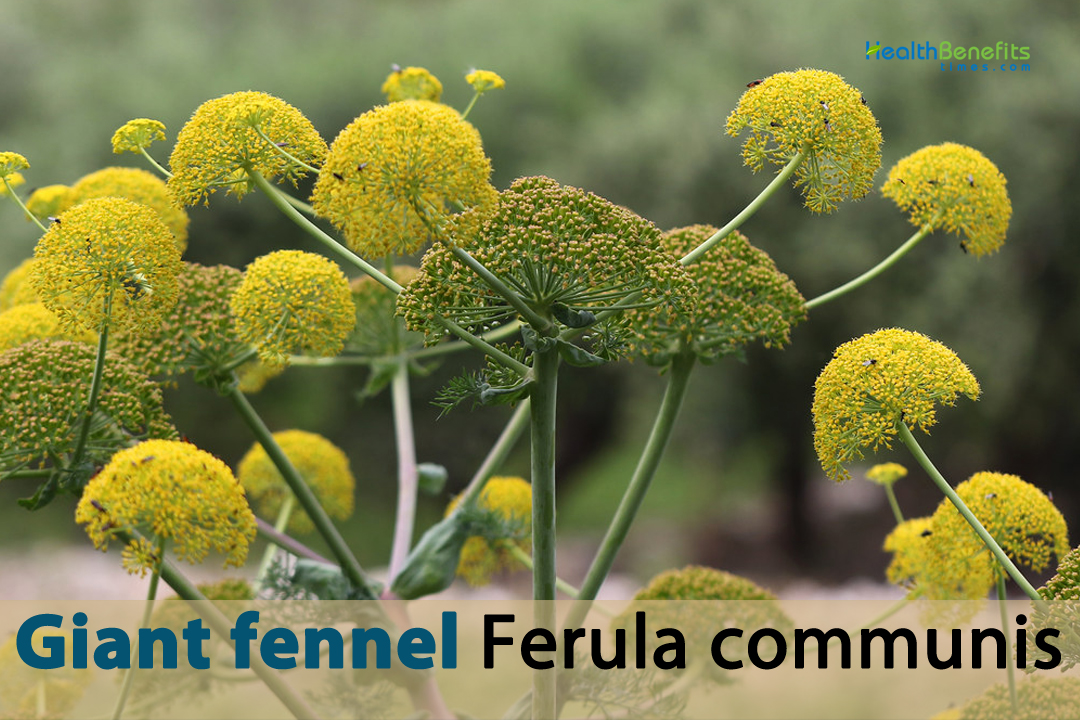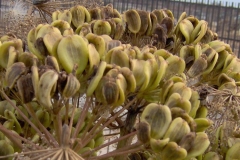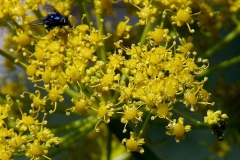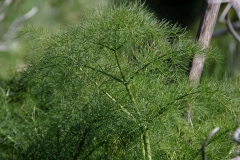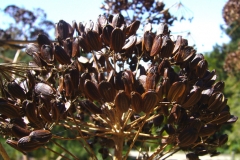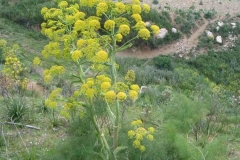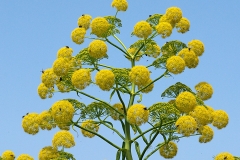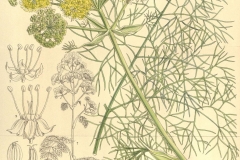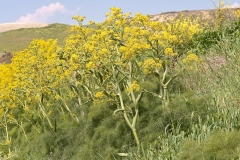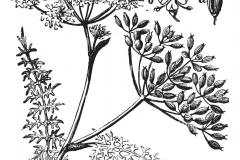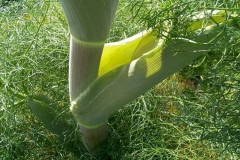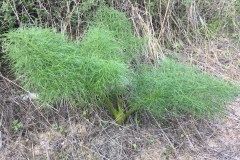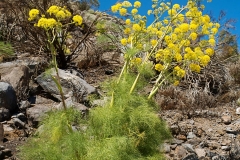| Giant fennel Quick Facts | |
|---|---|
| Name: | Giant fennel |
| Scientific Name: | Ferula communis |
| Origin | Mediterranean region, particularly in countries such as Spain, Italy, Greece, and North Africa |
| Shapes | Schizocarp is a dry fruit that splits into two or more pieces called mericarps |
| Taste | Strong and distinct anise-like flavor, which is sweet, aromatic, and slightly spicy |
| Health benefits | Digestive Health, Skin Health, Cardiovascular Health, Liver Support, Mental Well-being, Weight Management, Urinary Tract Health, Wound Healing, Oral Health, Blood Sugar Regulation |
| Name | Giant fennel |
|---|---|
| Scientific Name | Ferula communis |
| Native | Mediterranean region, particularly in countries such as Spain, Italy, Greece, and North Africa |
| Common Names | Ferula, Wild fennel, Giant fennel, Giant hog’s fennel, Broad-leaved giant fennel, Giant fennel dill, Turkish giant fennel, Black fennel, Ferula gummosa, Giant fennelweed, Sicilian fennel, Great fennel , Tall fennel, Masterwort, Ferula giant, Italian fennel, Wild giant fennel, Giant fennelwort, King’s fennel, Fennel giant-parsley, Ferula hermonis, Ferula jaeschkeana, Ferula karelinii, Ferula macrocarpa, Ferula orientalis, Ferula schair, Ferula tingitana, Ferula vesceritensis, Common giant fennel, Ferula caspica, Giant fennel root, Giant fennel parsley, Broadleaf fennel, Fennel giant, Black giant fennel, Tall giant fennel, Ferula persica, Ferula raddeana, Ferula caspica, Ferula rhaetica, Ferula canariensi |
| Name in Other Languages | Afrikaans: Reusefenkel Albanian: Hidherimë i Madh, Hudhra e madhe Amharic: Inidēti fenikili (እንዴት ፈንክል), dogi (ዶግ) Armenian: Masnavor Karaser (Մասնավոր Քարասեր) Arabic: Al-shamar al-‘amlak (الشمر العملاق), Shamar dakhm (شمار ضخم), Sa’at al-Shams (سعت الشمس) , Alshumoo Al’umlaqa (الشموع العملاقة), Aboubal, Besbas Harami, Fasoukh, Kelkh, kalkh kabir (كلخ كبير) Assamese: Maha sonph Asturian: Cañavana Azerbaijani: İri Şam otu, Adi ilankölgəsi Basque: Erruki Handia Belarusian: Veliznikavy fenhel (Велізнікавы фенхель) Bengali: Bishal mouri (বিশাল মৌরি), Bishal pundi (বিশাল পূন্ডি), Daruchini Gachh (দারুচিনি গাছ), Daitto Pan (দৈত্য পান), Damoni mourī (দামোনি মৌরি) Bosnian: Divlji kopar Bulgarian: Gigantska diva kopar (Гигантска дива копър), Gigantski fenel (Гигантски фенел) Catalan: Fonoll gegant, Canyaferla Chinese: Jù huí xiāng (巨茴香), Dà huí xiāng (大茴香), Jùdà huíxiāng (巨大茴香), Dà ā wèi (大阿魏) Croatian: Divlji kopar, Divlji koromač Czech: Obří fenykl, Obrovský fenykl Danish: Kæmpefennikel Dutch: Reuzenvenkel English: Giant Fennel, Common giant-fennel Estonian: Hiidkummel, Hiid-aniis Filipino: Higanteng Anis Finnish: Jättianis, Jättiläisfenkoli, Jättiläisenkurkkutilli, Jättiselleri, Välimerenkeltaputki French: Fenouil Géant, Férule commune, Grande Férule, Pamelier Georgian: Uprosi Surveli (უფროსი სურველი), Uladuri suneli (ულადური სუნელი) German: Riesenfenchel, Steckenkraut, Gemeines Rutenkraut, Gemeines Steckenkraut, Riesenfenchel Greek: Gígantas fennel (Γίγαντας φεννέλ), Gigantiaíos márathos (Γιγαντιαίος μάραθος), Nárthikas (Νάρθηκας) Gujarati: Motu Variyalu (મોટું વરીયાળું), Jambudī saunf (જમ્બુદી સૌંફ) Hebrew: Shumir Ra’anán (שומר רענן), Shum’er anak (שומר ענק) Hungarian: Óriás édeskömény, Óriás borsikafű Hindi: Vishaal sonph (विशाल सोंफ), Vishaal pindee (विशाल पिण्डी) Icelandic: Risafennel Indonesian: Adas Jumbo, Adas raksasa Irish: Finéal Reatha Italian: Finocchio Gigante, Ferula commune, Finocchiaccio Japanese: (Kyodai fennaru (巨大フェンネル), Jaianto uīdo (ジャイアントウィード), Jaianto Fenneru (ジャイアントフェンネル), Oouikyou (オオウイキョウ) Kannada: Dodda Sonpu (ದೊಡ್ಡ ಸೊಂಪು), Doddha suppu (ದೊಡ್ಡ ಸುಪ್ಪು) Kazakh: Shymkentti sabynshaq (Шымкентті сабыншақ) Kashmiri: Woor karan Konkani: Chahāṇa sāphaḷī Korean: Geodaehan deulg-ggae (거대한 들깨), Geodaehan Deulgga (거대한 들깨), Geodaehan yujacha (거대한 유자차) Kurdish: Xum Kelişîk Kyrgyz: Çayır çöp je çaar kuuray (Чайыр чөп же чаар куурай) Latin: Ferula communis Latvian: Milzīgais fenheils, Milzīgais fenheļa Lithuanian: Milžiniškas krapas, Milžiniškas fenelis Macedonian: Gigantska veligoza (Гигантска велигоза), Giganski koper (Гигантски копер) Malay: Jintan Besar Malayalam: Valiya perumjeerakam Manipuri: Amuba yai Marathi: Jad Badishep (जाड बडीशेप), Motha saunf (मोठा सौंफ) Nepali: Thulo Sauf (ठूलो सौफ) Norwegian: Gigantfennikel Odia: Bāṛa sonpā Oriya: Dedaka mourī (ଦେଡ଼କ ମୌରୀ) Persian: Avishan amadeh (آویشن عمده), Raziyane Bozorg (رازیانه بزرگ) Polish: Koper olbrzymi Portuguese: Funcho Gigante, Canafrecha Punjabi: Vaddā saunf (ਵੱਡਾ ਸੌਂਫ) Romanian: Fenicul uriaș, Fenicul gigant Russian: Gigantskiy fenkhel (Гигантский фенхель), Obyknovennyy krupnolistnyy fenkhel (Обыкновенный крупнолистный фенхель) Sanskrit: Brihad saunf Swedish: Jättefänkål, Jättestinkfloka Serbian: Divlji kopar, Divlji komorač Sinhala: Iwallocuwa (ඉවළ්ලොකුව), Vishāla sāmulu (විශාල සාමුළු) Slovak: Obrovský fenikel Slovenian: Divji komarček Spanish: Hinojo Gigante, Caña, Caña del muermo, Cañabeja, Canabeja común, Canaheja, Caña del muermo, cana, Cañaheja Swedish: Jättefänkål Tamil: Periya cerukkampu (பெரிய செருக்கம்பு) Telugu: Giāṇṭ sōmpu (గియాంట్ సోంపు) Thai: Phakkhīf̂aràng (ผักชีฝรั่ง) Turkish: Devrezene, Dev fesleğen, Dev Frenk Kimyonu Ukrainian: Hihantskiy fenkhel (Гігантський фенхель) Urdu: Bari Sonf (بڑی سونف), Baṛī saunf (بڑی سونف) Vietnamese: Tiểu hồi (Tiểu Hồi), Hương thảo khổng lồ Welsh: Ffenigl Mawr, ffenigl mawr |
| Plant Growth Habit | Tall herbaceous perennial plant |
| Growing Climates | Scrublands, open woodland, forest glades, rough grassland, pastures, ruderal communities, rocky and stony places, uncultivated land, mountain plain, river banks, pond margins, river beds, olive groves, coastal edges, steep hills or along hillsides |
| Soil | Prefers well-draining soil that is rich in organic matter. It can tolerate various soil types, including loam, sandy, or rocky soils. Ensure that the soil pH is within the slightly acidic to neutral range |
| Plant Size | 6 to 10 feet (1.8 to 3 meters) |
| Root | Root is thick, strong, and long. It keeps the plant firmly planted in the ground |
| Stem | Straight, tall, and leafy about 1 to 3 meters (3 to 10 feet) or even higher. It is round and the bottom is made of wood. The stem is hollow and has a hole in the middle |
| Bark | Rough and coarse texture, typically brownish-gray in color, with variations in shade depending on the age of the stem |
| Leaf | Leaf is made up of a number of small leaflets that are lined up along a center axis called the rachis. The leaves look like feathers or ferns because they are made up of more than one part and are bluish-green in color, giving it an airy and delicate appearance |
| Flowering season | From May to June |
| Flower | It has small flowers that are usually yellow in color. They are perfect flowers, which mean that they have both male and female parts that help them reproduce. |
| Fruit Shape & Size | Schizocarp is a dry fruit that splits into two or more pieces called mericarps. Each mericarps has a single seed. Two mericarps that are joined together make up a mature fruit. |
| Seed | Ovate or ellipsoid, and they are long. They are a little bit flattened and end in points |
| Flavor/Aroma | Leaves: Fresh and slightly sweet fragrance Stem: resinous, warm, and slightly spicy Seed: strong anise-like fragrance, with sweet and warm notes |
| Taste | Leaves: mild and slightly sweet taste with herbal undertones Stem: slightly spicy and resinous taste, with hints of bitterness Seed: strong and distinct anise-like flavor, which is sweet, aromatic, and slightly spicy |
| Plant Parts Used | Seeds, Leaves, Stem, Gum resin (Galbanum) |
| Propagation | By seed, division, Root Cuttings, Transplanting |
| Lifespan | 1-2 years |
| Season | From August to September |
| Major Nutrition |
|
| Varieties |
|
| Health Benefits |
|
| Different Forms |
|
Plant Description
Giant fennel is a tall herbaceous annual plant that grows between 1.8 and 3 meters (about 6 to 10 feet) tall. The plant grows in scrublands, uncultivated land, open woodland, rough grassland, pastures, forest glades, ruderal communities, olive groves, mountain plains, river banks, coastal edges, pond margins, rocky and stoney places, river beds, steep hills, or along slopes. The plant does best in dirt that drains well and has a lot of organic matter. It can grow in different kinds of dirt, like loam, sand, or rock. Make sure the pH of the dirt is between slightly acidic and neutral. The plant is taken from the wild and used as food, medicine, and a source of materials by the people who live there.
Appropriate growing environment for Giant fennel
Giant fennel is a plant species that has specific requirements for its optimal growth. Here are some key factors to consider when creating an appropriate growing environment for giant fennel:
- Climate: Giant fennel comes from the Mediterranean area and grows best in warm, temperate climates. It grows best in places where winters are warm and summers are hot and dry. The plant can’t handle freezing temperatures, so it does best in places with a Mediterranean or subtropical climate.
- Sunlight: Giant fennel needs full sun exposure to thrive. Choose a spot in your garden or growing area where the plant will get at least 6 to 8 hours of direct sunshine per day.
- Soil: The plant does best in dirt that drains well and has a lot of organic matter. It can grow in different kinds of dirt, like loam, sand, or rock. Make sure the pH of the dirt is between 6.0 and 7.5, which is a range from slightly acidic to neutral.
- Watering: Giant fennel can survive in dry conditions once it’s grown, but it needs to be watered often while it’s still young. To help the plant grow deep roots, water it less often and more deeply. Once the plant is established, water it less to make it look like it would in the Mediterranean, where it comes from naturally.
- Space: Giant fennel can grow to be between 6 and 10 feet (1.8 to 3 meters) tall and 4 to 6 feet (1.2 to 1.8 meters) wide. Leave enough space between plants to suit their size and keep them from being too close together.
- Protection: Giant fennel’s tall stems can be damaged by strong winds, so give them some shelter. If you plant fennel near a fence or wall, it can help block the wind.
- Propagation: You can grow giant fennel from seeds or by splitting up already-grown plants. Plant seeds in the ground or start them indoors before the last date for frost. Make sure the seeds are planted at the right depth and follow the germination steps for the type of plant you are growing.
Roots
Giant fennel has a taproot, which means it has one main root that goes straight down into the ground. This main root is thick, strong, and long. It keeps the plant firmly planted in the ground. The taproot goes deep into the ground, giving the plant access to water and nutrients in the lower layers of dirt. Lateral roots grow out from the main taproot. From the main root, these secondary roots grow out horizontally, spreading and growing into the dirt around them. The lateral roots help the plant get water and nutrients from a wider area. They also give the plant structure and support. Small, thin roots called fibrous roots can be found along the side roots. The job of these rootlets is to get water and minerals from the dirt. They have a lot of surface area, which makes it easier for the plant to take in nutrients.
Stem
The stem is straight, tall, and leafy. It usually grows to a height of 1 to 3 meters (3 to 10 feet) or even higher. It is round and the bottom is made of wood. The stem is hollow and has a hole in the middle that runs the length of it. This empty structure makes the stem lighter overall and gives it flexibility, so it can move with the wind without breaking easily. The stem has long furrows and lines that make it look like it has ridges or ribs. Along the length of the stem, these furrows and lines give it a unique look and feel.
Giant fennel stems can grow branches, which are new stems that grow from the main stem. These branches form in the same way and look the same, with hollow, furrowed, and grooved parts. Inside the stem, there are ducts or tunnels that carry a sticky sap. These tubes help move and store resin, which helps the plant defend itself against herbivores and disease-causing organisms. An apical meristem is a group of rapidly dividing cells at the tip of the stem. This group of cells is in charge of the growth and development of the stem. The apical meristem is where new leaves, stems, and flower stalk come from.
Bark
Outer layer of the bark is composed of dead tissue known as the periderm. This layer serves as a protective barrier against physical damage, pathogens, and environmental stresses. The bark has a rough and coarse texture. It is typically brownish-gray in color, with variations in shade depending on the age of the stem. Scattered across the bark are small openings called lenticels. Lenticels allow for the exchange of gases between the plant’s internal tissues and the surrounding atmosphere. They play a role in facilitating gas exchange and ensuring sufficient oxygen supply to the living tissues beneath the bark.
The cork cambium or phellogen is a layer of meristematic tissue that is found inside the bark. The cork cambium makes sure that new cork cells are always being made on the upper side of the bark. These cork cells slowly take the place of older, dead cells and help the bark layer grow and renew. Under the layer of cork is the secondary phloem, which is part of the bark. Sugars, nutrients, and other organic substances made in the leaves are moved to other parts of the plant by the secondary phloem.
Leaves
Leaves are complex, which means they have more than one leaflet. Each leaf is made up of a number of small leaflets that are lined up along a center axis called the rachis. The leaves look like feathers or ferns because they are made up of more than one part. The veins on the leaflets are pinnate, and each leaflet has one main vein, called the midrib, that runs down the middle. From the midrib, smaller veins branch out to make a network that brings water and food to the leaf tissue. The leaves are very cut up or deeply divided, which gives them a fine, lacy look. The leaflets are long and thin, and their ends are irregularly toothed or cut.
Each leaflet has a thin stalk called a petiole that connects it to the rachis. The leaflets can be placed at different angles because of the petioles. This helps them get the most sunshine for photosynthesis. Along the stem, the leaves are grouped in pairs. This means that each leaf grows from a different place on the stem. As the leaves move up the stem, they grow from different sides. Leaves can be different sizes, with those at the bottom of the stem usually being bigger than those at the top. Depending on the age and growing stage of the plant, the leaflets can be anywhere from a few centimeters to more than a foot long.
Flowers
Flowers are grouped in a way that looks like a compound umbel. Umbels are a type of inflorescence in which several flower stalks grow from one place, like the ribs of an umbrella. The main flower stalk, called the peduncle, grows from the plant’s stem and holds up the whole bouquet. Usually, it is long and strong, so it can hold the umbel high above the leaves. The first umbel comes out of the top of the stem. It is made up of several secondary umbels, each of which is connected to a pedicel, a secondary stalk. The number of secondary umbels can be anywhere from 10 to 30, but this is usually the case. Each secondary umbel is made up of a flat or slightly rounded cluster of many individual flowers. The stems of the secondary umbels all start in the same place on the main umbel. The Giant fennel has small flowers that are usually yellow in color. They are perfect flowers, which mean that they have both male and female parts that help them reproduce. Each flower is made up of these parts:
Calyx: The part of a flower that is on the outside. It is made up of several petals. The sepals are generally green, and they protect the flower bud as it grows. The corolla is the next ring inside the calyx. It is made of five flowers that are fused together. Most of the time, the petals are yellow and are made like a wheel. Stamens: There are five stamens inside the corolla. They are all around the center pistil. The stamens are the male sexual parts of a flower. They are made up of a filament and an anther, which is where the pollen is stored. The pistil is the female reproductive part in the middle of a flower. It has an ovary at the bottom, a style in the middle, and a stigma on top. The ovary holds the ovules, which become seeds when they are fertilized.
Fruits
Schizocarp is the name for fruit. A schizocarp is a dry fruit that splits into two or more pieces called mericarps. Each mericarps has a single seed. Two mericarps that are joined together make up a mature fruit. Each mericarps looks like a small seed because it is long, cylindrical, and slightly bent. A thin, long structure called the carpophore links the mericarps together. The carpophore helps get the fruit and seeds to where they need to go.
Seeds
The form of the seeds is ovate or ellipsoid, and they are long. They are a little bit flattened and end in points. The seed coat or testa is the outside layer of a seed. The shell is hard and protects the baby inside. The seed coat is dark brown or black and smooth or has a few small wrinkles on the surface. The hilum is a scar on the seed coat that shows where the seed stalk, or funiculus, connects to the seed. It is normally at one end of the seed and looks like a mark or depression.
The embryo, which is the young, immature plant, is inside the seed coat. The embryo has a radicle, which is the embryo’s root, a plumule, which is the embryo’s shoot, and cotyledons, which are the seed’s leaves. During sprouting, the radicle is the first structure to appear. It grows into the first root of the new plant.
Varieties of Giant fennel
There are several varieties of Giant fennel that exhibit slight differences in their characteristics, growth habits, and distribution. Here are some notable varieties of Giant fennel:
- Ferula communis subsp. communis: This is the most common type of Giant fennel, and it grows all over the world. It comes from the Mediterranean area and can be found in Spain, Italy, Greece, and Turkey, among other places. It grows most often in rocky places, along roads, and in open areas with dirt that drains well.
- Ferula communis subsp. glauca: This subspecies can only be found on the Greek island of Crete. It has glaucous or bluish-green leaves and grows in a tight, bushy shape. It likes to grow in dry, rocky places and does well in the temperature of the Mediterranean.
- Ferula communis subsp. eriocarpa: This subspecies can be found in North Africa, in places like Morocco and Algeria. It is known for its hairy fruits, which give it the popular name “Hairy-fruited Giant fennel.” It grows best in dry and semi-dry places with soils that drain well.
- Ferula communis subsp. maritima: This type is often called “Coastal Giant Fennel,” and it grows along the Mediterranean coast. Compared to other forms, it grows more tightly and is often found in sandy or rocky coastal areas.
- Ferula communis subsp. stocksii: This subspecies comes from the area around the eastern Mediterranean, which includes Turkey, Syria, and Lebanon. It stands out because its leaves are deeply cut and it grows quickly. It does best in soils that drain well, and you can often find it in open woods and on grassy hills.
- Ferula communis subsp. brevifolia: This type comes from the western Mediterranean islands of Mallorca, Menorca, and Ibiza, which are part of the Balearic Islands. Its leaves are shorter and wider than those of other types. It likes to live in sunny places and is usually found in rocky or brushy areas.
- Ferula hermonis: This type of fennel is native to the mountains of Lebanon, Syria, and Israel. It is also known as Mount Hermon huge fennel. It is a plant that comes back every year and can grow up to 6 feet (1.8 meters) tall. It has big leaves that look like ferns. Ferula hermonis has thick, hollow stems that hold umbels of yellow flowers. This type is known for having a strong scent.
- Ferula tingitana: This type of fennel is native to Morocco and Algeria in North Africa. It is often called Tangier giant fennel. It can get as tall as 10 feet (3 meters) and has fluffy leaves that are deeply split. Ferula tingitana has hollow stems that can look orange. It has groups of yellow flowers and a smell that is easy to recognize.
- Ferula gummosa: This type of huge fennel is native to Iran, Afghanistan, and other countries nearby. It is also known as galbanum. It can get as tall as 6 feet (1.8 meters) and has fluffy leaves that look like parsley. Ferula gummosa has yellow flowers and, as its name suggests, is known for its gum resin, which is used in perfumes, incense, and traditional medicine.
- Ferula akitschkensis: This type is native to Central Asia, especially Kazakhstan, Uzbekistan, and Tajikistan. It is often called Akitschk’s giant fennel. It can grow up to 9 feet (2.7 meters) tall and has leaves that are very small. Ferula akitschkensis has big clusters of yellow flowers called umbels, and it is known for having a pleasant smell.
- Ferula macrocarpa: This type of fennel, which is also called Large-fruited giant fennel, is native to the Mediterranean area, which includes Greece, Turkey, and Italy. It can grow up to 6 feet (1.8 meters) tall and has big leaves with serrated edges that are split into several parts. Ferula macrocarpa has groups of bright yellow flowers and seeds with bumps that make them stand out. It is valued for how pretty it looks.
- Ferula caspica: Ferula caspica comes from the area around the Caspian Sea, which includes Iran, Turkmenistan, and Kazakhstan. It is a tall annual plant that can grow up to 10 feet (3 meters) tall. It has feathery, deeply divided leaves like other types of huge fennel. The plant has big, dense clusters of yellow flowers that smell strong and nice. It is used as a spice in some dishes and in traditional healing.
- Ferula communis var. glauca: This type is a form of Ferula communis, and people usually call it Blue giant fennel. It comes from the area around the Mediterranean Sea, which includes Spain, Portugal, and Morocco. The leaves of blue giant fennel are bluish-gray, which makes it stand out from other kinds. It can get as tall as 6 feet (1.8 meters) and has bunches of yellow flowers. It is used in gardening because its leaves look nice.
- Ferula persica: This type is native to Iran and the areas around it. It is also called Persian giant fennel. It is a tall plant that can grow up to 9 feet (2.7 meters) tall. It has fern-like leaves that are split into small pieces. Ferula persica has big clusters of yellow flowers that smell strong and nice. It has been used in traditional medicine because of its health benefits, and it is also grown as a decorative plant.
- Ferula communis var. stocksii: Ferula communis var. stocksii is a tall annual plant that comes from Afghanistan, Pakistan, and other nearby places. It can grow up to 6 feet (1.8 meters) tall. It has feathery leaves that are very finely split, and it makes umbels of yellow flowers. This type is known for its strong scent and has been used in traditional medicine for its healing qualities.
Health benefits of Giant fennel
Giant fennel is a perennial herb that is native to the Mediterranean region. It has been used for centuries for its medicinal properties and is known for its distinct aroma and flavor. Apart from its culinary uses, giant fennel also offers several health benefits. Here are some of the additional health benefits of giant fennel in detail:
1. Digestive Health
Giant fennel has been used for a long time to help the digestive system. It has compounds with carminative qualities that may help relieve symptoms like indigestion, gas, and flatulence. These carminative qualities can help relax the smooth muscles of the digestive system and make digestion better.
2. Anti-inflammatory Properties
Some of the chemicals in giant fennel, like flavonoids and terpenoids, can help reduce inflammation. Inflammation is the body’s natural reaction to an injury or infection, but long-term inflammation can lead to a number of diseases. The anti-inflammatory properties of giant fennel may help lower inflammation and help people with conditions like arthritis and inflammatory bowel disease feel better.
3. Respiratory Support
In the past, giant fennel was used to treat problems with the lungs. It might help coughs, asthma, and congestion feel better. The plant can help soften and get rid of mucus, which makes it easier to breathe. But more study is needed to fully understand how much better it is for your lungs.
4. Antimicrobial Effects
Some tests show that giant fennel might be able to kill germs. Some chemicals in the plant may help stop bacteria and fungi from growing. Even though these are only early results, they suggest that giant fennel could be used to treat microbial illnesses. Still, more study needs to be done to confirm these effects and figure out how they work.
5. Antioxidant Activity
Some of the antioxidants in giant fennel are flavonoids and phenolic substances. Antioxidants help protect the body from the damage that free radicals can do to it. Antioxidants may help lower the risk of chronic diseases and slow down the ageing process by getting rid of free radicals. But more study is needed to find out exactly what antioxidant effects giant fennel has and what they might mean for health.
6. Hormonal Balance
Some studies show that giant fennel may affect how hormones work together. It is thought to have phyto-estrogenic traits, which means that it can make the body act like oestrogen. This property could help women who are having menopause signs like hot flashes, mood swings, and trouble sleeping.
7. Diuretic Effects
Giant fennel is a natural diuretic that causes more pee to be made and helps the body get rid of toxins and extra fluid. This result can help people who have trouble getting rid of water, have urinary tract infections, or have problems with their kidneys.
8. Skin Health
Giant fennel is good for the health of your skin because it has anti-inflammatory and antioxidant qualities. It might make the face less red, irritated, and inflamed. Also, the herb’s antioxidants can protect the skin from damage caused by free radicals, making the skin look healthier and younger.
9. Anti-microbial Properties
Giant fennel kills bacteria and fungus by stopping them from reproducing. Terpenes and phenols, which are found in the herb, can help stop the growth of dangerous microorganisms. This effect may help strengthen the immune system and avoid infections by killing germs.
10. Anti-cancer Potential
Some research has shown that big fennel can help fight cancer. Some compounds in the herb, like ferutinin and umbelliferone, have shown promise in early studies as anti-tumor agents. But more research needs to be done to fully understand how giant fennel could help avoid and treat cancer.
11. Cardiovascular Health
Due to its antioxidant and anti-inflammatory effects, giant fennel may help keep your heart healthy. These qualities help reduce oxidative stress and inflammation in the blood vessels, which could lower the chance of heart disease. The herb may also help keep cholesterol levels and blood pressure in a safe range.
12. Antispasmodic Effects
Giant fennel has been used for a long time to stop muscle spasms. It may help relax smooth muscles and ease spasms in the digestive system, respiratory system, and urinary systems. Conditions like irritable bowel syndrome (IBS), asthma, and urinary cramps can be helped by this.
13. Liver Support
In the past, giant fennel was used to help keep the liver healthy. It might help the liver work better, help the body get rid of toxins, and protect it from toxic damage. These benefits can be good for the liver as a whole and help keep it working at its best.
14. Mental Well-being
Aromatherapy has used the smell of giant fennel to help people relax and feel better about them. People think that the smell of the herb calms them down and reduces worry and anxiety. Giant fennel has been used in some countries to help people focus and stay on task.
15. Weight Management
Giant fennel may help you lose weight because it makes you pee and helps your body digest food. The diuretic effect helps you get rid of extra water weight, and the stomach support helps you digest food well and absorb nutrients. But it’s important to remember that to keep a good weight, you need to eat well and exercise regularly.
16. Urinary Tract Health
Giant fennel is a diuretic, which means it makes you pee more and helps flush toxins out of your body. This effect can help keep your urinary system healthy, stop urinary tract infections, and lower your risk of getting kidney stones.
17. Wound Healing
The antiseptic and antimicrobial qualities of the essential oils in giant fennel can help wounds heal faster. When you put giant fennel oil on small cuts, wounds, or bug bites, it may help avoid infections and speed up the healing process.
18. Anti-allergic Effects
Some study shows that giant fennel might be good for people with allergies. It might help with allergy symptoms like sneezing, itchy, and stuffy nose. The anti-inflammatory effects of the herb may help the body respond less to allergens and have less of an allergic reaction.
19. Oral Health
Giant fennel is good for your mouth health because it kills bacteria. Gargling with a weak solution of giant fennel extract or using it as an ingredient in natural mouthwashes may help reduce bacteria in the mouth, stop bad breath, and support gum health.
20. Blood Sugar Regulation
Some studies show that giant fennel may have a hypoglycemia effect, which means that it can help control the amount of sugar in the blood. People with diabetes or those who are at risk of getting it may benefit from this trait. But more study needs to be done to fully understand how giant fennel affects how well blood sugar is controlled.
21. Antipyretic Effects
Giant fennel has been used to treat fevers for a long time. The herb might help bring down the body’s temperature and relieve fever signs like headaches and body aches.
Traditional uses and benefits of Giant fennel
- Seeds and resin have been used as expectorants, diuretics, and digestive aids.
- They have also been used in medicines to treat breathing problems, help wounds heal, and treat other illnesses.
- It has been used to treat breathing problems like asthma and coughs.
- The plant’s resin is a sedative and has also been used to treat diabetes.
- It has been used to treat hysteria and dysentery for a long time.
- In Saudi Arabia, the rhizomes are used as a natural remedy to treat skin infections.
- Roasted flower buds are used to treat fever and dysentery.
- Mashed fresh kernels help get rid of bloody humors in the mouth and treat stomachaches with diarrhea.
- It is also suggested as a way to treat snakebites.
Culinary uses of Giant fennel
Giant fennel, also known as Ferula communis is a plant native to the Mediterranean region. It is widely used in culinary applications for its unique flavor and aroma. Here are some detailed culinary uses of giant fennel:
- Aromatic Seasoning: Giant fennel has a strong, sweet, and slightly spicy smell that makes it a great addition for seasoning. Spices are often made from the seeds, especially in Mediterranean and Middle Eastern cooking. Before being used in recipes, the seeds are often roasted or ground.
- Flavoring Liquids: Giant fennel can be used to give drinks its unique flavor. For example, the seeds can be added to a pot of hot water to make stocks, broths, or soups. This gives the drink a light, anise-like flavor, which improves the taste of the dish as a whole.
- Baking: Giant fennel seeds can be added to baked goods to make them taste different. They are often used in bread, biscuits, cakes, and cookies. You can add a mild, fragrant flavor to baked goods by grinding seeds and adding them to the dough or sprinkling them on top.
- Pickling: Giant fennel stems and bulbs can be pickled to keep them fresh and add flavor. To pickle giant fennel, you can mix vinegar, water, sugar, and spices (like mustard seeds, peppercorns, and fennel seeds) in a pot, bring the mixture to a boil, and then pour it over the prepared fennel bulbs or stems. Let them cool down and soak for a few days before you eat them. Giant fennel that has been pickled can be eaten as a side dish or added to salads and sandwiches.
- Vegetable Side Dish: Giant fennel stalks and seeds can be cooked and eaten as a side dish. To bring out their natural flavors, you can sauté, grill, or roast them. Giant fennel tastes a little bit sweet, like celery, and can be cooked and eaten in the same way.
- Herbal Teas: Herbal teas can be made with giant fennel seeds. You can soak crushed or ground fennel seeds in hot water for a few minutes to make fennel seed tea. The tea that comes out of this has a calm, fragrant taste and is often drunk to help with digestion.
- Culinary Garnish: Giant fennel has feathery leaves that can be used to decorate different recipes. The fronds look like delicate ferns and can be used to make salads, soups, and seafood meals look nicer.
- Seasoning for Fish and Seafood: Fish and seafood recipes go especially well with giant fennel. You can season grilled, baked, or pan-seared fish with the seeds or chopped leaves. The aromatic flavor goes well with the delicate tastes of the fish, giving the dish more depth and complexity.
- Marinades and Rubs: Meat, fowl, or tofu can be marinated or rubbed with the seeds. When giant fennel seeds are mixed with other herbs, spices, and liquids, they make a delicious coating that can make the protein taste better. You can mix the ground or crushed seeds with things like garlic, lemon juice, olive oil, salt, and pepper to make a marinade or rub for grilling or baking.
- Flavored Oils and Vinegars: You can flavor oils or vinegars by putting giant fennel seeds in them. To flavor the oil or vinegar with the seeds, put them in a bottle and let them sit for a couple of weeks. The flavored oil or vinegar that comes out of this process can be used in salad dressings, marinades, or as a final touch on different foods to add a subtle fennel note.
- Herbal Butter or Compound Butter: Giant fennel can be added to herb butter or compound butter that you make at home. Just cut the leaves into small pieces and mix them with softened butter and any herbs or spices you like. The flavored butter you get can be used as a spread or melted and drizzled over grilled meats, veggies, or pasta dishes.
- Infused Syrups: Simple syrups can be flavored with giant fennel to give drinks and sweets a unique taste. In a pot, mix water, sugar, and crushed fennel seeds to make syrup that tastes like fennel. Bring the mixture to a boil and stir until the sugar is dissolved. Let it cool down, and then strain the seeds out. The infused syrup can be added to cocktails, mock tails, iced teas, lemonades, and sweets like cakes and fruit salads to make them sweeter.
- Flavoring Rice and Grains: Giant fennel seeds can be added to rice and other grains while they are cooking to give them a mild, fragrant flavor. When making rice, quinoa, couscous, or other grains, just add a teaspoon or two of fennel seeds to the hot water or broth. The end result is a tasty side dish that goes well with many different main dishes.
- Fennel Salt: Giant fennel seeds and coarse sea salt can be mixed together to make a tasty fennel salt. Lightly toast the fennel seeds in a dry pan, and then use a mortar and pestle or a spice grinder to grind them with sea salt. This homemade fennel salt is a unique way to add a finishing touch to roasted veggies, grilled meats, or even freshly popped popcorn.
- Fennel Vinegar: White wine vinegar or apple cider vinegar can be flavored with giant fennel seeds in the same way that oils can be. Pour the vinegar over the seeds in a sterilized glass bottle or jar. Close the jar and put it in a cool, dark place for a few weeks. The fennel vinegar you make can be used in salads, marinades, or even as a tangy addition to sauces and soups.
- Fennel Pesto: By adding giant fennel stalks to the traditional pesto recipe, you can make a tasty sauce. In a food processor or blender, mix together fresh basil leaves, pine nuts, garlic, Parmesan cheese, olive oil, and chopped fennel stalks. Blend until smooth, adding more olive oil if needed to get the right consistency. You can spread this fennel pesto on sandwiches, put it on pasta, or add it to grilled veggies to make them taste better.
- Fennel Sprouts: Giant fennel’s tender, young leaves can be added to salads or used as a unique garnish. These sprouts taste a little bit like fennel and have a nice crunch. Just wash and trim the shoots, then add them to salads or use them to top soups and stews.
- Fennel Desserts: Giant fennel can even be used to add sweetness and a hint of anise flavor to sweets. Ground fennel seeds can be added to cookie or cake recipes, or they can be mixed with milk or cream to make custards, ice creams, or panna cottas. Fennel can also be added to pies, cakes, or fruit compotes with oranges, apples, or pears for a unique twist.
- Fennel Infused Spirits: Giant fennel has a strong smell that can be used to flavor drinks like vodka, gin, or even rum. Crush some fennel seeds and put them in a bottle with your favorite spirit. Let it sit for a few days to a couple of weeks, based on how strong you want the flavor to be. The result is a spirit that tastes like fennel and can be used to make drinks.
Different Uses of Giant fennel
Certainly! Here are different uses of giant fennel in detail:
- Essential Oil Production: The seeds of giant fennel are a good source of essential oil, which is made by steam distilling the seeds. The oil is used in perfumes, soaps, and cosmetics because of its pleasant smell. It is also used in massage because of how it calms and soothes.
- Animal Fodder: Giant fennel can be fed to animals as a forage plant. Animals eat its leaves, roots, and seeds, which give them food and flavor. Also, the plant’s strong smell might keep some pests away.
- Soil Stabilization: Giant fennel is sometimes planted in places where soil is likely to wash away because it has deep roots and grows in a dense mat. The plant’s large root system helps hold the earth together, stopping soil erosion and making it more stable.
- Ornamental Plant: Giant fennel can be grown as an ornamental plant in parks because it grows tall and has pretty leaves. The plant’s feathery fronds and architectural shape make it an interesting addition to settings because it adds texture and visual interest.
- Insect Repellent: Some insects stay away from giant fennel because of its strong smell. You can use crushed fennel leaves or fennel essential oil as a natural bug repellent to keep mosquitoes, flies, and ants away. It’s important to remember, though, that giant fennel may not work as well as commercial bug repellents and may not work at all.
- Craft and Artistic Uses: Stems and leaves from giant fennel can be used in many craft and art projects. The hollow stems can be dried and used as natural straws, or they can be cut and put together to make unique structures or artistic pieces. The feathery fronds can be used to make wreaths, flower arrangements, and other artistic things.
- Aromatic Potpourri: Giant fennel’s dried seeds, stems, and leaves can be used to make a potpourri that smells good. When put in bowls or sachets, the plant’s nice smell can make rooms smell better. You can make your own potpourri blends by putting dried fennel together with other herbs, flowers, or spices.
- Natural Dye: Giant fennel’s roots and leaves can be used to make a natural yellow dye. When the plant parts are boiled in water, they can produce a yellowish color that can be used to dye linens, yarns, and other natural materials. By trying out different mordants or mixing plant dyes with each other, you can make a wide range of colors.
- Biomass and Biofuel: People have thought about giant fennel as a possible source of biomass and energy. It grows quickly and makes a lot of biomass, which makes it a good choice for renewable energy. The plant can be grown and taken for its biomass, which can be turned into biofuels like bioethanol or biogas.
- Bee Forage: Bees and other pollinators are drawn to the flowers of giant fennel, which makes it a useful plant for keeping bee numbers high and helping pollination in the area. Planting giant fennel can help local environments stay healthy and full of different kinds of life.
- Traditional Rituals and Folklore: In some places, giant fennel is important because of its history and culture. It has been used in ceremonies, traditions, and folklore for a long time. For example, in some countries, people thought that fennel could protect and clean, so it was used in ceremonies for births, weddings, and other important events.
- Natural Repellent for Snails and Slugs: People have said that giant fennel can keep snails and slugs from coming into lawns. Putting fennel leaves or stems around plants that are vulnerable or using fennel to make a natural shield may help keep these pests away.
- Biomass Mulch: Giant fennel stems and leaves can be chopped up and used as mulch in a yard. When spread around plants, biomass serves as a protective layer that helps keep soil moist, stops weeds from growing, and adds organic matter as it breaks down.
- Traditional Crafts and Weaving: Giant fennel has long, strong leaves that can be used to make crafts and weave. They can be cut into pieces and sewn together to make baskets, rugs, and even furniture. Because the roots are strong and flexible, they can be used in different ways to weave.
- Herbal Remedies: Traditional herbal treatment has used giant fennel because it might be good for your health. People think that infusions or decoctions made from the parts of the plant may help with things like indigestion, bloating, breathing problems, and menstrual pain. But before using giant fennel as medicine, it’s important to talk to a medical expert.
- Natural Insecticide: There are natural chemicals in giant fennel that kill insects. It can be used to keep bugs out of plants in a natural way. Without using man-made poisons, extracts or sprays made from the plant can help keep insects away or kill them.
- Fiber Production: Giant fennel has roots that are tough and can be used to make fiber. This fiber can be used for many different things, like making clothes, ropes, and even paper. The fiber is good for these uses because it is strong and lasts a long time.
- Erosion Control: Giant fennel is often used in projects to stop erosion because it has deep roots and can grow in hard circumstances. Its wide network of roots helps stabilize soil on hills, stopping soil erosion and making it easier for other plants to grow.
- Animal Habitat Enhancement: Giant fennel’s dense growth and tall structure can give small animals and bird’s protection and a place to live. It makes a safe place for wildlife in natural areas or parks by giving them places to nest and shelter.
- Aesthetic and Aromatherapy Products: Giant fennel is used to make beauty goods and products for aromatherapy. Its extracts and essential oil are used in perfumes, soaps, lotions, and candles with a smell. Giant fennel gives these goods a unique touch with its strong smell.
- Wildlife Food Source: Birds and small mammals eat the seeds of giant fennel. The plant can help keep the environment in order by giving these animals food.
- Educational and Research Purposes: Giant fennel is often used in schools or research labs to learn about plant biology, environment, or how it can be used to treat diseases. It is interesting to study because of how it grows, what it is made of chemically, and other things.
Side effects of Giant fennel
While giant fennel has culinary and medicinal uses, it’s important to be aware of potential side effects and precautions. Here are some known side effects of giant fennel:
- Photosensitivity: Some of the chemicals in giant fennel can make the skin more sensitive to the sun. If you touch the plant or its sap directly, especially if your skin is exposed, you may have a phototoxic response that makes your skin red, blister, or itch when you go outside.
- Allergic Reactions: Some people might be allergic to giant fennel or any of its parts. Allergic reactions can be mild or serious, with symptoms like itching, rashes on the skin, swelling, trouble breathing, or anaphylaxis. If you are allergic to other plants in the Apiaceae family, like carrots, celery, or parsley, use giant fennel with care.
- Pregnancy and Breastfeeding: Women who are pregnant or nursing should stay away from giant fennel because we don’t know enough about its safety during these times. Before taking giant fennel in any form during pregnancy or while nursing, it is best to talk to a doctor.
- Drug Interactions: Some medicines, like blood thinners and drugs that help control diabetes, may not work well with giant fennel. There are chemicals in the plant that can change how blood clots and how much sugar is in the blood. Before using giant fennel, you should talk to a doctor or nurse if you are on any medicines. This will help you avoid any possible drug interactions or side effects.
- Digestive Disturbances: When eaten in large amounts, giant fennel can cause stomach problems like bloating, gas, or diarrhea in some people. Use giant fennel in moderation and pay attention to how your body reacts.
- Skin Irritation: People with sensitive skin may get skin irritation or dermatitis if they come into direct touch with the plant or its sap. When working with giant fennel, it’s best to wear gloves to avoid getting skin problems.
- Medication Potentiation: Due to its pharmacological features, giant fennel may make the effects of some medicines stronger. If you are taking any prescribed medicines along with giant fennel, you should let your doctor know. This will keep you safe and help you avoid any problems that could arise.
- Hormonal Effects: Giant fennel has chemicals in it that may act like estrogen in the body. This means that it could affect hormone levels, especially in people with hormonal imbalances or diseases like cancers that are sensitive to estrogen. If you have any of these conditions, you should be careful and talk to a doctor before using giant fennel.
- Gastrointestinal Irritation: In some cases, eating giant fennel can irritate the digestive tract, which can cause stomach pain, sickness, or vomiting. This can happen if a lot of the plant is eaten or if a person is especially sensitive to the chemicals in it.
- Respiratory Distress: When sensitive people breathe in giant fennel pollen or come into contact with the plant’s volatile chemicals, they may have trouble breathing or an allergic reaction. This can show up as coughing, wheeze, shortness of breath, or signs that are similar to asthma.
- Interference with Medications and Medical Procedures: Giant fennel, especially in concentrated forms like essential oil or supplements, could make some medicines or medical treatments not work as well as they should. For instance, it might change the way blood clots or react with sedation. If you are going to have surgery or are taking medicines, you should tell your doctor if you use giant fennel. This will help you avoid any problems that could arise.
- Photosensitization in Livestock: When exposed to sunlight, animals that eat a lot of giant fennel may become sensitive to light and have skin reactions. This can cause skin to become inflamed, boil, or feel like it has sunburn.
References:
http://www.theplantlist.org/tpl1.1/record/kew-2808370
https://npgsweb.ars-grin.gov/gringlobal/taxon/taxonomydetail?id=16606
https://pfaf.org/user/Plant.aspx?LatinName=Ferula+communis
https://www.cabidigitallibrary.org/doi/10.1079/cabicompendium.82620
https://temperate.theferns.info/plant/Ferula+communis
https://en.wikipedia.org/wiki/Ferula_communis


